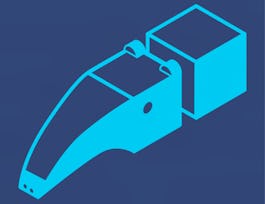In this first course of the specialization, we will discuss the limitations of the Internet for business and economic activity, and explain how blockchain technology represents the way forward. After completing this course, you will be able to explain what blockchain is, how it works, and why it is revolutionary. You will learn key concepts such as mining, hashing, proof-of-work, public key cryptography, and the double-spend problem. You’ll be able to describe seven design principles for blockchain technology, and the challenges facing the people developing it. You’ll also meet the players in the blockchain ecosystem, and consider your own role in stewarding the blockchain revolution.



Introduction to Blockchain for Financial Services
This course is part of Blockchain Revolution in Financial Services Specialization


Instructors: Don Tapscott
Sponsored by IEM UEM Group
23,862 already enrolled
(660 reviews)
What you'll learn
The limitations of the Internet for business and economic activity, and how trust is established in a pre- and post-blockchain world
Terms such as miner, hash, nonce, proof-of-work, and public key cryptography, as well as the steps of a blockchain transaction
Seven design principles for blockchain technology
Ten challenges associated with implementing blockchain technology
Skills you'll gain
Details to know

Add to your LinkedIn profile
32 assignments
See how employees at top companies are mastering in-demand skills

Build your subject-matter expertise
- Learn new concepts from industry experts
- Gain a foundational understanding of a subject or tool
- Develop job-relevant skills with hands-on projects
- Earn a shareable career certificate


Earn a career certificate
Add this credential to your LinkedIn profile, resume, or CV
Share it on social media and in your performance review

There are 5 modules in this course
The Internet connects billions of people around the world, and is great for communicating and collaborating online. However, because it was built for moving and storing information, and not value, it has done little to change the way we do business. Now, for the first time in human history, two or more parties anywhere in the world can transact and do business peer to peer using the blockchain. In this module we introduce blockchain as “the trust protocol,” and explain how it represents the second era of the Internet. We describe how blockchain technology establishes trust—not through powerful intermediaries, but rather through collaboration, cryptography and clever code.
What's included
14 videos8 readings6 assignments3 discussion prompts
We believe that the next era of the digital economy can be shaped around a set of blockchain design principles, which can be used for creating software, services, reinventing business models, markets, organizations, and even governments. This module frames the blockchain revolution around seven design principles. For each principle we describe a current problem to be solved, identify “blockchain breakthroughs” to these problems, and discuss the implications of these breakthroughs on the digital economy. We hope that these design principles will assist learners in contemplating their roles and their futures in the blockchain revolution.
What's included
12 videos8 readings6 assignments
The advent of blockchain technology forces us to reconsider the upside and downside of public revelation of transactions and contracts. The implementation, application, and possible regulation of distributed ledgers involve choices that will critically affect information disclosure and economic interactions. Whether the ledger is public and permissionless, such as the Bitcoin or Ethereum blockchains, or private and permissioned, such as the Ripple or Hyperledger implementations, in principle transactions on a blockchain have a high native level of transparency. In this module, you will learn how privacy can can be protected in both public and private ledgers using both procedural and technological methods.
What's included
13 videos4 readings5 assignments1 discussion prompt
Although blockchain technology emerged from the open source community, it quickly attracted many stakeholders, each with different backgrounds, interests, and motives. In this module, you will explore the roles and perspectives of nine categories of stakeholders within the blockchain ecosystem, including industry pioneers, venture capitalists, developers, governments, regulators, leaders, and end users.
What's included
8 videos2 readings4 assignments1 discussion prompt
Like every revolutionary technology, the blockchain has its upside and its downside. In this module we discuss ten implementation challenges which must be overcome as we transition to the second era of the Internet. For each challenge, you will also learn about potential solutions and what we can do to ensure the fulfillment of the blockchain’s promise.
What's included
18 videos11 readings11 assignments1 discussion prompt
Instructors


Offered by
Why people choose Coursera for their career




Learner reviews
660 reviews
- 5 stars
77.42%
- 4 stars
18.93%
- 3 stars
3.18%
- 2 stars
0.45%
- 1 star
0%
Showing 3 of 660
Reviewed on Jan 7, 2022
Its a great course designed to share every aspect of Blockchain. The recommended course material given are also very extensive and helpful.
Reviewed on Jun 20, 2020
This course has been the best source for me to learn what blockchain technology is all about in very easy-to-understand terms. It was very informative and the instructors were impeccable.
Reviewed on Apr 20, 2020
Complete, sound and proven work - this course has taught so much in so less time! Some readings are just so engrossing that it makes you jump off the chair...enjoyed every bit!
Recommended if you're interested in Computer Science

University of Minnesota

EIT Digital

University of California, Irvine

Open new doors with Coursera Plus
Unlimited access to 10,000+ world-class courses, hands-on projects, and job-ready certificate programs - all included in your subscription
Advance your career with an online degree
Earn a degree from world-class universities - 100% online
Join over 3,400 global companies that choose Coursera for Business
Upskill your employees to excel in the digital economy



